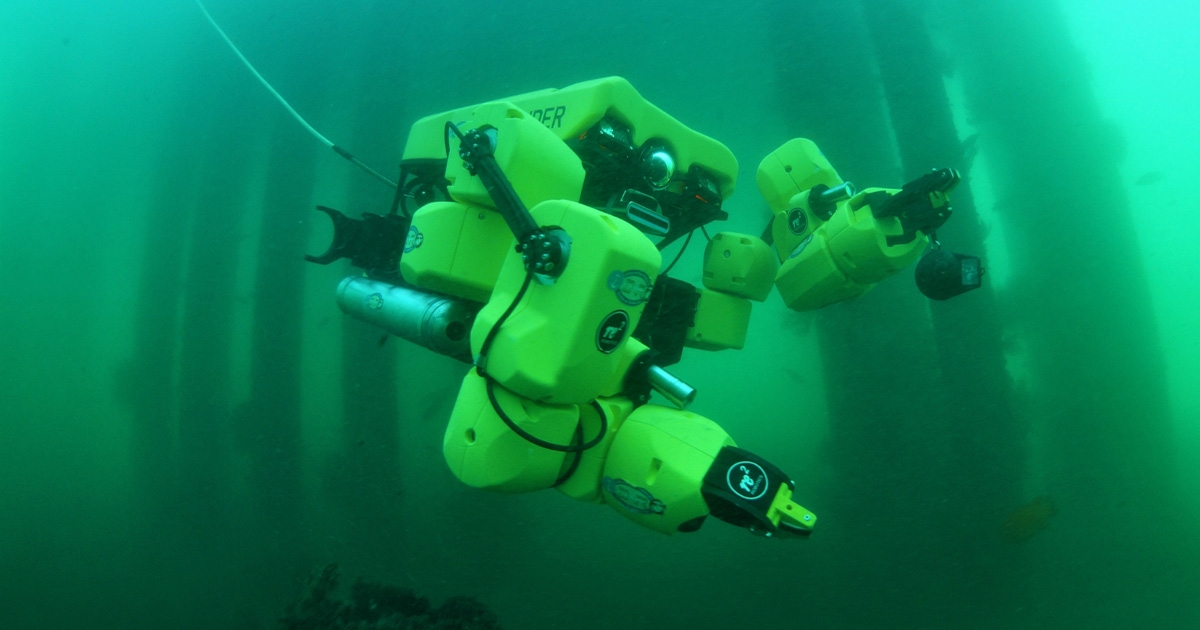The Future of Underwater Robotic Systems Technology

VideoRay is the world’s leading manufacturer of underwater, portable, inspection-class underwater robotic systems also known as ROVs. VideoRay’s Mission Specialist underwater robotic systems are used around the world to support national security, first responders, object search and recovery, infrastructure examination and science and research.
The Mission Specialist Defender system is VideoRay’s largest and most powerful configuration, optimized for precise control, heavier payloads, lifting and specialized operations. The Defender system has seven thrusters for exceptional maneuverability. It can move in any direction and maintain active pitch to move the vehicle in an upward or downward orientation.
The Mission Specialist Pro 5 system is designed for speed, efficiency and portability and handles missions with size, space, weight, and deployment speed constraints.
AUTONOMOUS OPERATION
Engineers at VideoRay are rapidly developing technological advances and leveraging artificial intelligence (AI) to enable our underwater robotic systems to autonomously perform increasingly complex and hazardous jobs in the most challenging conditions. Autonomous control is applied to piloting and navigation tasks and intervention jobs like manipulator control for capturing images, cleaning, grabbing and measuring. Autonomous systems also simplify data collection, analysis, and reporting.
Semi-autonomous control reduces the required level of human operator engagement because the vehicle uses sensor data to understand and react to its environment and perform tasks. Fully autonomous systems will leverage artificial intelligence and machine learning to function entirely without the control of a human operator.
Underwater robotic technologies that VideoRay will begin rolling out commercially through new Mission Specialist modules include:
- Object perception and recognition systems informed by AI to achieve fully autonomous underwater robot operation. These capabilities can provide a better picture of the underwater environment, enabling the system to locate and identify objects before humans can. This technology saves time and money and helps keep divers out of dangerous situations.
- Point cloud modeling uses the system’s sensors, cameras and lasers to collect data points from an underwater object and generate a 3D model of the subsea environment. AI detects, locates and classifies objects and enables mapping technologies to autonomously control the thrusters. Equipped with point cloud modeling technology, the system will be able to process data about its surroundings to navigate within that space, classify the environment in relation to its task, perform inspections and manipulative tasks, then report on its mission.
- Distance deployment to send an underwater robot for a long-range mission is challenging because the system uses a tether to transmit communications back and forth from the underwater robot to the control panel on shore or on a ship. That means personnel can deploy the vehicle only as far as the tether allows. However, an underwater robotic system with an autonomy engine module powered by a subsea Edge computer processor will support system control at the vehicle. With Edge technology, communications will be possible no matter the distance through the water via a wireless acoustic modem using communication networks such as radio frequency, wi-fi or satellite.
- Underwater resident systems to house a fleet of robots for large recurring jobs will eliminate the need for operators to be present on-site because charging and maintenance can be performed remotely. Resident systems technology will enable a network of robotic systems to monitor and maintain subsea assets by flying scheduled automated patterns and sending personnel the data wherever they are located.
COMMERCIAL APPLICATIONS
Autonomous and perceptive technologies have many commercial applications, and VideoRay is excited to bring these advances to its customers. The autonomy engine module is a subsea Edge processor which enables system control at the vehicle. Subsea vehicle batteries provide power at the vehicle instead of at the surface through the umbilical. This will enable the system to operate and “return home” if the umbilical is severed. This battery technology also will facilitate tether-less robot operations.
Because VideoRay customers can be up and running quickly—completing successful missions within just a few weeks of purchase—they enjoy a rapid return on their investment. In addition, they also protect their investment. Every system from VideoRay can be upgraded to integrate these technologies at any time—without having to buy a new system. Customers who purchased a Mission Specialist system years ago can upgrade the vehicle and extend its capabilities by simply adding an updated tool or sensor module. That includes the AI and perceptive technologies as we roll them out commercially.
COLLABORATION WITH THE U.S. NAVY
VideoRay is working with the U.S. Navy and several integration partners to develop innovative perception and autonomous technology for underwater robotic systems to help keep vessels and personnel safe during explosive ordnance disposal (EOD) missions.
VideoRay is currently fulfilling a large and diverse order by the U.S. Navy for its Mission Specialist Defender systems. The Navy is standardizing on VideoRay Defender Mission Specialist systems due to their superior capabilities, flexibility and upgradability of the large number of systems deployed since 2019. VideoRay’s customer support for the Navy includes training facilities and personnel in Pottstown, Pennsylvania, and in San Diego, California.
In addition to the U.S. Navy, VideoRay has delivered or has firm orders from 20 other navies and coast guards from allied nations. As a result of these orders and commercial orders, VideoRay expects revenue in 2022 to be roughly double that of 2021 and is in the process of building up its manufacturing capacity to meet growing demand.
As these autonomous control innovations come to market, VideoRay experts are on hand to help customers select the latest tool and sensor modules to accomplish missions safely and efficiently.
For more information, visit www.videoray.com or call +1 610-458-3000.
This feature originally appeared in Ocean News & Technology's Magazine December 2022 edition. To read more, access the magazine here.

